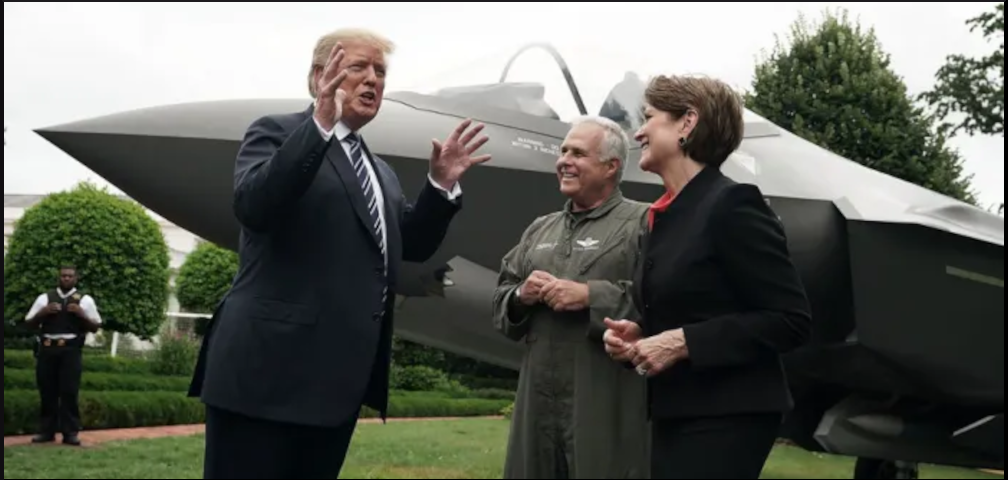by Jeremy Kuzmarov, published on Covert Action, December 30, 2020
Huge Military Budgets, Covert Operations, Drones and Assassinations—but hey, at least he didn’t start another major war
By any objective measure, Donald Trump has been one of the worst presidents in American history.
His administration exacerbated inequalities, fomented social divisions, encouraged nativist and white supremacist groups, gutted environmental protections, mishandled the Covid-19 crisis, and tarnished the office of the presidency in a way that no president ever has or probably ever will.
On foreign policy, Trump’s legacy is just as bad as in every other area.
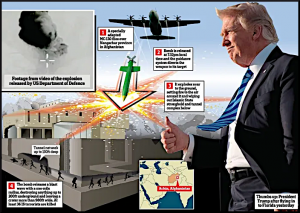 His administration shamefully (1) pulled out of the Iran nuclear agreement and Paris climate change accords, (2) expanded the drone war, (3) dropped the mother of all bombs on Afghanistan, (4) loosened restrictions on air strikes in the Middle East, causing a spike in civilian casualties, (5) pardoned a Navy Seal (Eddie Gallagher) who posed with the mutilated body of an Islamic state captive and four Blackwater mercenaries who killed seventeen civilians in Baghdad’s Nisour Square, (6) supported right-wing coups in Bolivia and Venezuela, (7) restored the cruel Cold War policy towards Cuba, (8) unveiled more than 3,900 sanctions actions including against the chief prosecutor of the International Criminal Court (ICC) in a blatant attempt to protect U.S. government officials, (9) expanded arms sales to Saudi Arabia, which totaled $3.35 billion in 2018, (10) vetoed measures to end U.S. involvement in the war in Yemen, (11) unfroze military aid to Egypt despite the massive human rights abuses of General Fatah-al-Sissi, and (12) pulled out of the Inter-Nuclear Forces (INF) arms control treaty with Russia on spurious pretexts.
His administration shamefully (1) pulled out of the Iran nuclear agreement and Paris climate change accords, (2) expanded the drone war, (3) dropped the mother of all bombs on Afghanistan, (4) loosened restrictions on air strikes in the Middle East, causing a spike in civilian casualties, (5) pardoned a Navy Seal (Eddie Gallagher) who posed with the mutilated body of an Islamic state captive and four Blackwater mercenaries who killed seventeen civilians in Baghdad’s Nisour Square, (6) supported right-wing coups in Bolivia and Venezuela, (7) restored the cruel Cold War policy towards Cuba, (8) unveiled more than 3,900 sanctions actions including against the chief prosecutor of the International Criminal Court (ICC) in a blatant attempt to protect U.S. government officials, (9) expanded arms sales to Saudi Arabia, which totaled $3.35 billion in 2018, (10) vetoed measures to end U.S. involvement in the war in Yemen, (11) unfroze military aid to Egypt despite the massive human rights abuses of General Fatah-al-Sissi, and (12) pulled out of the Inter-Nuclear Forces (INF) arms control treaty with Russia on spurious pretexts.
In one respect, though, Trump may have been better than most of his predecessors—he did not start any major new wars.
Also on the positive side, Trump (1) withdrew troops and took some steps to end the Afghanistan War, (2) raised questions about the purpose of NATO, (3) cut funding for Pakistan because it subsidized the Taliban, (4) pushed for cuts to the African military command (AFRICOM), (5) withdrew U.S. troops from Somalia, and (6) made efforts at diplomatic engagement with North Korea and Russia, which did not sit well with the traditional foreign policy establishment.
Record Military Budgets
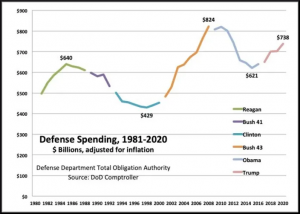
During the 2020 election campaign, Trump said that all Pentagon leaders “want to do nothing but fight wars so that all of those wonderful companies that make the bombs and make the planes and make everything else stay happy.”
However, in 2020 Trump signed off on a $721.5 billion Pentagon budget—the largest in its history—and military spending totals of around $934 billion.
His first three defense secretaries had deep ties to military defense contractors and his fourth, Christopher Miller, served as a Special Forces assassin in Afghanistan and Iraq.[1]
For 2018, Trump approved more than $55.6 billion in foreign weapons sales, compared to $33.6 billion in foreign military sales in fiscal 2016, the last year of the Obama administration.
Most disturbing of all, perhaps, was Trump’s attempt to institutionalize a culture of military worship that is characteristic of fascist states.
In a book by former family friend Stephanie Winston Wolkoff, Trump is said to have wanted his inauguration to look more like Pyongyang than Washington.
“I want tanks and choppers. Make it look like North Korea,” he said, according to the author.
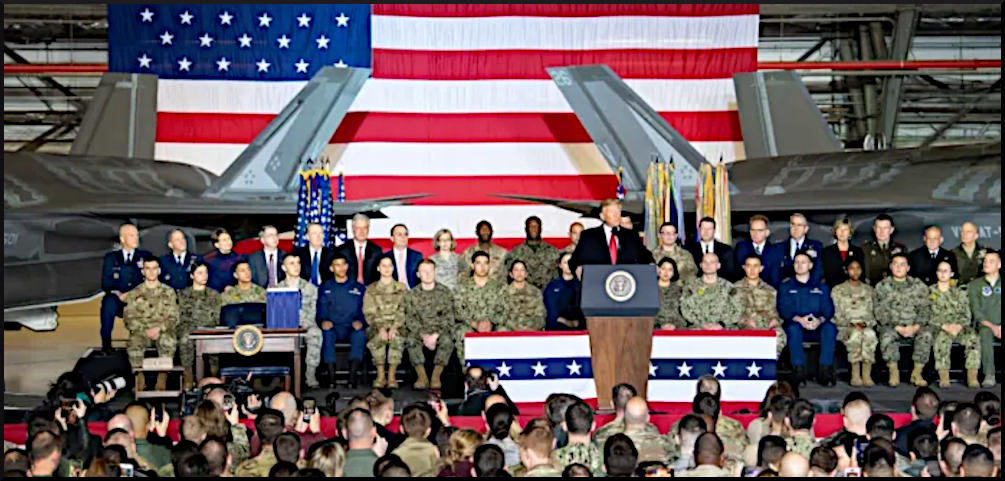
Fake Dove
Before he became president, Trump never took any principled stands on foreign policy. As a youth, he had attended the New York Military Academy but gained a deferment from the Vietnam-era draft on medical grounds by claiming that he had bone spurs. Trump said that he was against the Vietnam War, which he called “ridiculous,” but also said that he never attended any protests, as he “had better things to do.”
When asked about his favorite historical figures, Trump cited Theodore Roosevelt, General Douglas MacArthur, and General George S. Patton, who were all rabid war hawks. He told the New York Times during the 2016 presidential campaign that “if we had Douglas MacArthur today or if we had George Patton today and if we had a president that would let them do their thing you wouldn’t have ISIS, okay?”
Trump paradoxically tried to capitalize on a mood of disillusionment with “forever wars” by invoking the name America First, which harked back to a major right-wing antiwar organization of the 1930s, and criticized rivals like Jeb Bush and Hillary Clinton for supporting the Iraq War.
Trump’s insincerity was reflected in his choice of Zalmay Khalilzad to introduce him at one of his major foreign policy campaign speeches during the 2016 campaign.
A chief planner of the anti-Soviet war in Afghanistan during the 1980s, Khalilzad served as George W. Bush’s ambassador to Afghanistan (2003-2005) and Iraq (2005-2007) and was part of the Project for a New American Century, a group of neoconservatives who pushed for the war in Iraq.
The choice of Khalilzad foreshadowed his appointment of Bush-era retreads and foreign policy hawks like John Bolton and Mike Pompeo to top foreign policy posts.
Trump and his vice president, Mike Pence, were especially close to Erik Prince, the former head of Blackwater, who offered to build Trump a private covert action army.
According to a New York Times investigation, Prince helped recruit former American and British spies for secretive intelligence-gathering operations that included infiltrating Democratic congressional campaigns, labor organizations and other groups considered hostile to the Trump agenda. These actions exemplify how the adoption of illiberal methods overseas helped to compromise democracy at home during the Trump years.
“As Supportive as any President:” Trump and Israel
During the 2020 election, Trump was favored by Israelis by almost 45 percentage points. He had been “as supportive of Israel as any president since 1945,” one analyst wrote.

In December 2017, Trump extended official U.S. recognition of Jerusalem as the capital of Israel, which struck a blow against the Palestinians who want to establish East Jerusalem as the capital of a future Palestinian state.
When a new U.S. embassy was unveiled six months later, Israeli soldiers killed dozens of Palestinian protesters on the Gaza border.
In 2019, Trump signed a presidential proclamation affording recognition of Israel’s sovereignty over the Golan Heights, which had been seized from Syria following the 1967 six-day war. U.S. Secretary of State Mike Pompeo also signed a declaration that the “establishment of Israeli civilian settlements in the West Bank is not per se inconsistent with international law.”
In a final gratuitous gift to the right-wing Netanyahu government, Pompeo in November visited the annexed Golan Heights and a settlement in the occupied West Bank. These moves, unprecedented for a sitting Secretary of State, were designed to legitimate Israeli claims to these territories while emphasizing how little the U.S. is interested in Palestinian statehood or basic rights.
Trump and Russia
During the 2016 campaign, Trump brought some hope for better relations between the U.S and Russia which had deteriorated during President Obama’s second term. However, Trump was mercilessly attacked when he met with Russian President Vladimir Putin and accused of being a Russian agent, without foundation.
The Russophobic climate pushed Trump to adopt a hard-line policy that extended the new Cold War. In 2019, the Trump administration pulled out of the INF agreement and insinuated that it would not renew the new Strategic Arms Reduction Treaty (New START), another nuclear arms reduction treaty, which expires in 2021.
Trump also extended economic sanctions directed against Russia, in some instances in response to accusations that had not been verified, such as Russia’s alleged poisoning of ex-military intelligence officer Sergei Skirpal, which was never established.
Trump angered Russia further by providing lethal military aid—including Javelin antitank rocket launchers—to Ukraine, which was fighting a dirty war in its eastern provinces against Russian proxies, and by participating in military training activities with the Ukrainians, such as the September 2017 Rapid Trident air exercise and the October 2018 Clear Sky exercise.
Some 13,000 people have been killed in the war in Eastern Ukraine, the majority by the Ukrainian military, which includes neo-Nazi battalions.
If Trump was a Russian agent, he certainly did not act like one.
Intermarium and the Move Away from Old Europe
This past summer, Trump rankled the foreign policy establishment when he announced the withdrawal of 12,000 U.S. troops from Germany.
However, one thousand of those troops were redeployed to Poland as part of a new defense cooperation agreement signed in August 2020 on the anniversary of the victory of Poland in the Polish-Soviet war of 1920.
The new troops in Poland added to the 4,500 that were previously deployed by President Barack Obama following the 2014 Western-backed coup d’état in Ukraine and the Russian takeover of Crimea.
They reflected a strategic shift of U.S. administrations moving the core of NATO from Paris and Bonn—what Donald Rumsfeld famously termed “old Europe”—to the East, as part of an aggressive drive to control former parts of the Soviet Union and Central Asia.
As CAM reported, a central goal was to resurrect the Intermarium—a geopolitical concept originating in the post-World War I era that envisages an alliance of countries reaching from the Baltic Sea over the Black Sea to the Aegean Sea that would serve as an alternative power bloc between Germany and Russia.
In March 2018, Poland signed a $4.75 billion deal to purchase U.S. Patriot missile defense systems from Raytheon, the largest arms procurement deal in Polish history.
Russian Deputy Foreign Minister Vladimir Titov told Sputnik News that the Patriot deployments were “part of a U.S. plot to surround Russia with missile defense systems under the pretext of mythical threats to security.”
These comments epitomize how Trump’s military buildups and expansion of arms sales in Eastern Europe were helping to inflame tensions with Russia as part of the new Cold War.
Support for Color Revolution in Belarus
Another policy furthering this end was the Trump administration’s support for regime change in Belarus, which has been led by Socialist Alexander Lukashenko since the mid-1990s.
In August 2020, after Lukashenko won a contested election, thousands of Belarusians poured into the streets. Though presented as pro-democracy champions, they waved Belarus’s pre-revolutionary flag from the period before the 1917 Russian revolution, included far-right wing elements, and supported a political candidate who wanted to privatize Belarus’s mostly state-controlled economy.
Lukashenko has considerable support because he had effectively resisted “shock therapy,” or rapid privatization programs, in the 1990s that decimated Russia’s economy, and kept inequality levels and poverty rates below that of any Western European country.
Secretary of State Pompeo voiced public support for the regime-change advocates and the National Endowment for Democracy (NED), which had taken over CIA functions at the end of the Cold War, spent almost three million dollars in Belarus in helping to lay the groundwork for the color revolution. Its aim was to impose a pro-Western and neoliberal regime like in Ukraine, which would support NATO expansion and draw Belarus away from the Russian orbit, though Lukashenko remains in power as of this writing.
Expansion of the U.S. Military Base Network in Greece
On October 5, 2019, U.S. Secretary of State Pompeo and Greek Foreign Minister Nikos Deridias signed a Mutual Defense Cooperation Agreement whereby Greece allowed the U.S. to (1) expand a deep water naval base used by the U.S. 6th fleet in Crete and (2) invest heavily in a new naval and air force base in Alexandroupolis, which is emerging as a regional energy center.
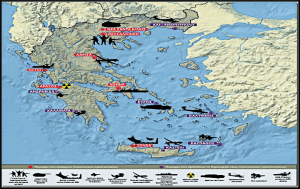
U.S. ambassador to Greece Geoffrey Pyatt, who had played a key role orchestrating the 2014 coup in Ukraine, stated after the defense agreement was signed:
Together with Greece and other democratic partners, we are working to push back on malign actors like Russia, China and Iran [that] have different interests and values and different visions for the future of this region.
These comments suggest a new Cold War imperative underlying the U.S. militarization of Greece and an effort to divide the world between so-called pro- and anti-democracy forces.
Thousands of Greeks felt differently and called on Mike Pompeo to go home as they protested the defense agreement in Athens. Dimitris Koutsoumpas, general secretary of the Communist Party of Greece (KKE), said,
The signing of the new agreement between Greece and the U.S., and in particular the maintenance and expansion of U.S. military bases in Greece, will only lead to even greater insecurity for the Greek people and further destabilize the region, with an even greater involvement in interventions, overseas missions and imperialist wars. That’s why we have proclaimed ‘no’ to all of them today.
Trump’s Drone War
According to the Bureau of Investigative Journalism, the Trump administration launched 13,100 drone strikes through early December 2020 in Afghanistan, Pakistan, Yemen and Somalia with the following breakdown: Afghanistan 11,766; Pakistan 6; Yemen 173; and Somalia 161.[2]
This compares with 1,978 for Obama during his eight-year presidency, although monitoring for Afghanistan only started in 2015. Obama’s breakdown was: 1,306 in Afghanistan from January 2015 until January 2017; 375 in Pakistan; 162 in Yemen; and 35 in Somalia.
The civilian deaths in Afghanistan for drone strikes caused by Trump range from 1,756-7,041 for Afghanistan, 16-25 in Pakistan, 213-283 in Yemen, and 896-961 in Somalia.
The number of people injured and traumatized is also extremely high.
In 2016, Trump issued an executive order revoking an Obama-era policy requiring U.S. intelligence officials to publish the number of civilians killed in drone strikes outside of war zones. The Trump administration said the rule was ”superfluous” and “distracting.” The real intention was to better hide the human cost of the drone war in order to limit antiwar dissent and evade legal censure.
Missiles over Masks
The Trump administration’s fiscal 2021 budget included a major increase in nuclear weapons spending from both the Defense Department and the agency in charge of managing nuclear warheads at a time when progressives were urging the government to prioritize “masks over missiles.”
The $46 billion requested by Trump was rubber-stamped by the Democratic-led House Armed Services Committee, which signed off on funding for the B61-12 gravity bomb, the Long-Range Standoff Weapon, and the Ground-Based Strategic Deterrent––which faced serious scrutiny over their perceived redundancy and exorbitant costs.
The Pentagon’s shift in outlook from counter-terrorism to “great power competition” with Russia and China resulted in not only a major campaign to modernize America’s nuclear weapons, but also a large-scale naval expansion unseen since the days of Franklin and Theodore Roosevelt.
Additionally, the Trump administration modernized the Air Force through the accelerated procurement of advanced combat planes, and vastly increased investment in emerging technologies like artificial intelligence, robotics, hypersonics, and cyber warfare.
In August 2019, Trump authorized the creation of the United States Space Command, citing the need for a centralized unit to protect American interests in what he called “the next war-fighting domain.” The protection of American satellites from Russia and China, which are developing antisatellite weapons, was a key goal, though Trump’s successors may well find another inter-galactic species to confront.
Trump’s War on Drugs—The 1980s and 1990s Playbook
During the 2020 election campaign, President Trump attacked Joe Biden—with some justification—as a central architect of the disastrous War on Drugs.
However, Trump expanded funding to the Drug Enforcement Administration (DEA) while adopting what one analyst termed “the 1980s and 1990s drug war playbook.”
Trump went so far as to praise Filipino strongman Rodrigo Duterte and expand military aid to the Philippines despite Duterte’s adoption of draconian drug-control methods, which resulted in the deaths of thousands of drug suspects.
In the fall of 2019, Trump administration officials pushed for the resumption of chemical fumigation of drug crops in Colombia using Glyphosate, the main ingredient in the weedkiller Roundup, manufactured by Monsanto, which has been found by several U.S. juries to be carcinogenic. Trump also sent 800 U.S. troops into Colombia to assist local law enforcement as an extension of the ill-fated Plan Colombia, which Biden had sponsored back in the 1990s.
Despite its failure to reduce the drug supply, Plan Colombia served as a model for the Mexican Plan Mérida, which Trump expanded—even though Mexico’s left-leaning president, Andrés Manuel López Obrador, said that he “did not want the Mérida initiative … We don’t want armed helicopters. We want production and work.”
The failings of the war on drugs were epitomized by Trump’s embrace of Honduran President Juan Orlando Hernández as a “proven partner”—despite the fact that Hernández was propelled into office, according to prosecutors, with the help of a million-dollar bribe from former Sinaloa Cartel leader Joaquín “El Chapo” Guzmán.
Hernández’ brother, Juan Antonio Hernández, a former congressman, was found guilty by a New York jury of trafficking cocaine into the U.S. and he had allegedly enabled drug cartels to infiltrate the Honduran government through bribery. The U.S. Attorney’s Office in the southern district of New York accuses Juan Orlando Hernández of taking money “to facilitate the use of Honduran armed forces personnel as security” for traffickers moving cocaine.
Trump and China
On July 4, 2020, the U.S. Navy dispatched an unprecedented two aircraft carriers and four other warships to the South China Sea for naval maneuvers in waters claimed by China. Mike Pompeo subsequently broke with the official U.S. policy of neutrality in territorial conflicts in the South China Sea and declared that China’s claims to most of the Sea were “completely unlawful,” though many of the disputed territories had been part of China prior to being taken over by Japan in the 1895 Sino-Japanese War.
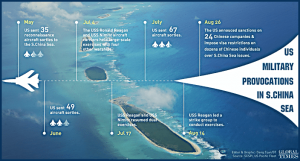
Trump’s administration also (1) imposed high tariffs on China, (2) approved more than $13 billion in arms sales to Taiwan, which China regards as a breakaway nation, (3) helped fast track a $3 billion sale of General Atomics drones to India whose armed forces clashed with the Chinese in June 2020, (4) signed a bill signaling support for anti-Chinese protesters in Hong Kong, and (5) blacklisted Chinese companies for China’s alleged aggression in the South China Sea.
Pompeo stated, in a speech at the Nixon library in Yorba Linda, California, that
if we want to have a free 21st century, and not the Chinese century of which Xi Jinping dreams, the old paradigm of blind engagement with China simply won’t get it done. We must not continue it and we must not return to it.
On July 21st, the New York Times ran a front-page article highlighting the revival of the Committee on the Present Danger, a Cold War organization revived by Trump’s former aide Steve Bannon, that called for greater military spending to meet the Soviet threat, but whose focus is now on China. The rising Sinophobia was epitomized by a Pew Research Center poll, which found that 73 percent of Americans had an unfavorable view of China, the highest in at least 15 years. These numbers indicate a readiness for war, which the Trump administration helped lay the groundwork for.
Bombing Syria on False Pretenses
In 2017 and 2018, the Trump administration launched air strikes on Syria in response to alleged chemical weapons attacks by the regime of Bashar al Assad.
Defense Secretary James Mattis called the second operation a “one-time shot” that was aimed at sending a strong message to “Assad and his murderous lieutenants.”
According to Syrian state news, nine civilians were killed in the 2017 U.S. air strikes, including four children, and another seven civilians were wounded when a missile hit homes in Al-Manzul, four kilometers away from the Shayrat air base, which had been targeted. (The strikes were a prelude to the bombing and shelling of the northern city of Raqqa which resulted in 1,600 civilian deaths, according to Amnesty International).
The 2018 strikes struck a scientific research center in Damascus, which the U.S. claimed was a center for research, development, production and testing of chemical and biological weapons.
The Russian government claimed that on April 2017, the date of the first alleged chemical attack, the Syrian air force had struck with conventional weapons a terrorist munitions depot which produced chemical warfare munitions.
Disclosures by Wikileaks and anonymous whistleblowers cast further doubt about whether the second chemical weapons attack ever took place, and showed that Trump administration officials pressured the Organization for the Prohibition of Chemical Weapons (OPCW) to repress a report that pointed to the attack having been staged.
This was all par for the course for the Trump administration, which followed its predecessors in deceiving the public, trampling on international law, and working to compromise the integrity of the UN.
Regime Change in Iran and Assassination of Soleimani
No overview of Trump’s presidency would be complete without discussing his belligerence towards Iran.
Trump surrounded himself with Iran regime change hawks like John Bolton and Mike Pompeo, and allowed his campaign to be financed by casino mogul Sheldon Adelson who was so extreme that he once proposed launching a nuclear weapon into the Iranian desert—as a negotiating tactic!
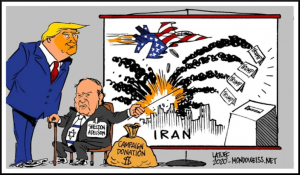
Trump combined this belligerence with inflammatory tweets and threats to destroy Iran’s major cultural sites. The assassination of General Qasem Soleimani in January 2020 was Trump’s signal achievement in his scheme to overthrow the Iranian government.
According to political analyst Michael Hudson, it was intended to escalate America’s presence in Iraq to keep control of the region’s oil reserves, and to back Saudi Arabia’s Wahabi troops (ISIS, Al Qaeda in Iraq, Al Nusra and other divisions of what are actually America’s foreign legion) to support U.S. control of Near Eastern oil as a buttress of the U.S. dollar.
In one final act of angry retribution, the Trump administration gave the green light for Israeli assassins to take out Iranian scientist Mohsen Fakhrizadeh, who was falsely billed as a “key architect of Iran’s nuclear program.”
The residue from this and other attacks will undoubtedly linger for years, having helped poison U.S.-Iranian relations irrevocably.
CFR Report Card and CAM’s
A 2019 report authored by Robert Blackwill of the Council on Foreign Relations (aka Wall Street’s think tank) entitled: “Trump’s Foreign Policies Are Better Than They Seem,” gave President Trump a D+ on foreign policy.
The grade was based in part on what Blackwill considers to be Trump’s appeasement policy toward Russia, his alienation of traditional American allies, and his failure to mobilize global opposition to climate change.
Blackwill, however, sees many positives in Trump’s foreign policy, and gave him a high grade in specific areas. For example, Blackwill gave Trump a B+ for his China policy, which he says helped “awaken” people in the U.S. and the world to the “growing threat that China poses to U.S. vital interests and democratic values.”
Blackwill also praised Trump’s staunch support for Israel, his strengthening relations with India under Hindu nationalist Narendra Modi, his keeping U.S. troops in Syria, pulling out of the Iran nuclear deal, and his maintenance of good bilateral relations with Saudi Arabia despite some of its “problematic policies.” For Venezuela, Blackwill gave out another B+, praising Trump’s mobilization of international opposition to socialist leader Nicolas Maduro, whom Blackwill termed a “corrupt strongman.”
In line with a generally positive appraisal, Blackwill writes that history teaches us that “flawed individuals and policy processes sometimes produce successful results. Like Wagner’s music, Trump’s foreign policy is better than it sounds.”
CovertAction Magazine gives Trump a very poor grade like Blackwill, however, for entirely different reasons.
For China, Saudi Arabia, Israel, India and Venezuela, we give Trump an F for his dangerous military provocations, arming of human rights abusers to the teeth, and for applying cruel sanctions in the case of Venezuela that have been responsible for thousands of deaths.
In our assessment, Trump’s foreign policy should not be compared to a great composer who might have been flawed: It should be compared to presidents and tyrants of ages past who misallocated national resources and were violent and erratic.
Trump has left us with a dismal legacy of bloated military budgets, expanded basing infrastructure, increased executive secrecy, gratuitous military provocations, and worsening relations with rival powers like Russia and China that will be difficult to overcome.
Grade: D-

Jeremy Kuzmarov is Managing Editor of CovertAction Magazine.
[1] Jim Mattis was a member of the General Dynamics board of directors, Pat Shanahan was an executive with Boeing, and Mark Esper was Raytheon’s top lobbyist.
[2] Syria and Iraq where drone strikes extended to were not measured.
